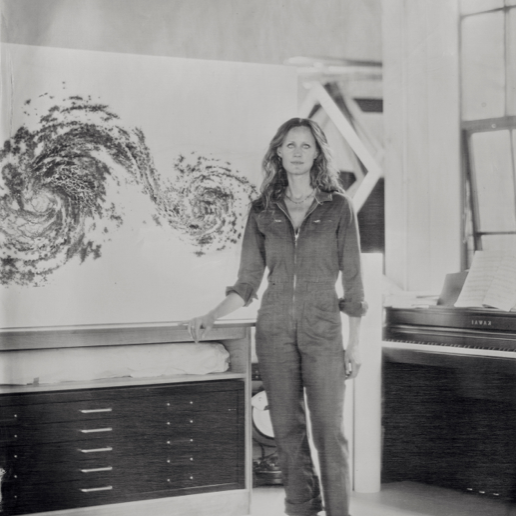
Emilie Pugh was born in London in 1988 and studied at Byam Shaw School of Art and at the Ruskin School of Art and Drawing at Oxford University.
Emilie Pugh’s work is guided by an interest in the interconnectivity of all living things. It draws on systems of belief from the spiritual to the scientific, the micro to the macro and the conflicting or confluent universal forces that govern them. She experiments with a wide range of mediums and processes and often uses unconventional methods of mark making. For the past few years she has been honing the technique of burning into Japanese paper, perforating holes or scorching the surface with a soldering iron, often stacking several panels together to create a multilayered three dimensional artwork.
‘Everything is in flux, evolving, growing, dying and dissolving in a perpetual cycle. I am compelled by the tensions that exist between the transient and the permanent; between form and the void, and what is material and immaterial.’ Emilie Pugh
Emilie Pugh has exhibited internationally with solo shows in London, Berlin and more recently Mumbai with Galerie Isa – ‘Patterns of Consequence ‘, (2023). She has shown in group exhibitions and art fairs in Europe and the USA. In 2013 Pugh was awarded a 6 month residency at Atelierhaus Mengerzeile in Berlin. Her work is in the collections of The Dorchester Hotel, The Nobu Hotel and Soho House.
She currently lives and works in London.
Artist Q&A with Emilie Pugh
by Dr Claudia Milburn
Q. What first inspired your practice?
A. I have always been preoccupied with the passage of time and the ephemeral nature of things. I looked for materials that embody some of these properties. I have been working with a burning technique for about ten years, perforating through different papers, layering them on top of each other and building up forms using the void. I like the effect of the burnt edge; the halo of sepia. It draws on this idea the Japanese have a word for ; wabi sabi, which promotes an appreciation of a transient beauty that reflects the irreversible flow of life towards decay.
Q. Tell me more about your subject matter for your work?
A. I am interested in the interconnectivity of all living things. I am drawn to universal forms that repeat themselves on a micro and macro scale like the spiral within a cyclone or the dendrite like patterns in capillaries or tree branches. I am also interested in how things move and grow. From fluid dynamics within cloud systems to the sacred geometry within a sunflower seed head.
Q. Why has paper become the principal medium for your practice?
A. It is a material that is easy to burn in a controlled way. It is both strong while giving the impression of lightness and fragility. I have explored many different types of paper – drawn to them for their aesthetic value and feel as well as well as their intrinsic properties. If I fall in love with a paper like I have with this Japanese kozuke paper, I will use it even if it is the wrong weight and size; working with paper conservationists to find ways to stick papers to together to make them larger and thicker.
Q. How significant is the element of serendipity in your practice?
A. It is very important in the experimental phase. Accident can lead you to discovering new techniques and ideas but you need to stay very open to clues which means letting go of the direction you had in mind.
Q. What is the most challenging element of your practice?
A. The process of burning has its challenges. I need to wear a gas mask and use a loud extractor fan to protect me from the smoke. These can prevent me from getting into the meditative state of flow as I stop and start as its physically more demanding. They can sometimes catch fire which means I need to redo layers. Then there is the unpredictable nature of how paper behaves if you want it to stay flat and smooth so I am constantly having to find new solutions to stretching paper.